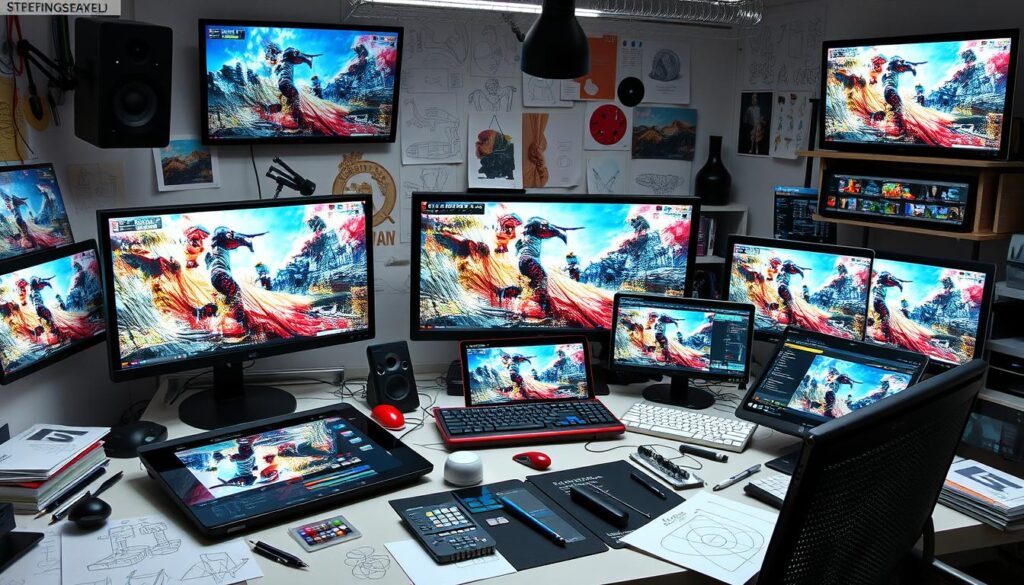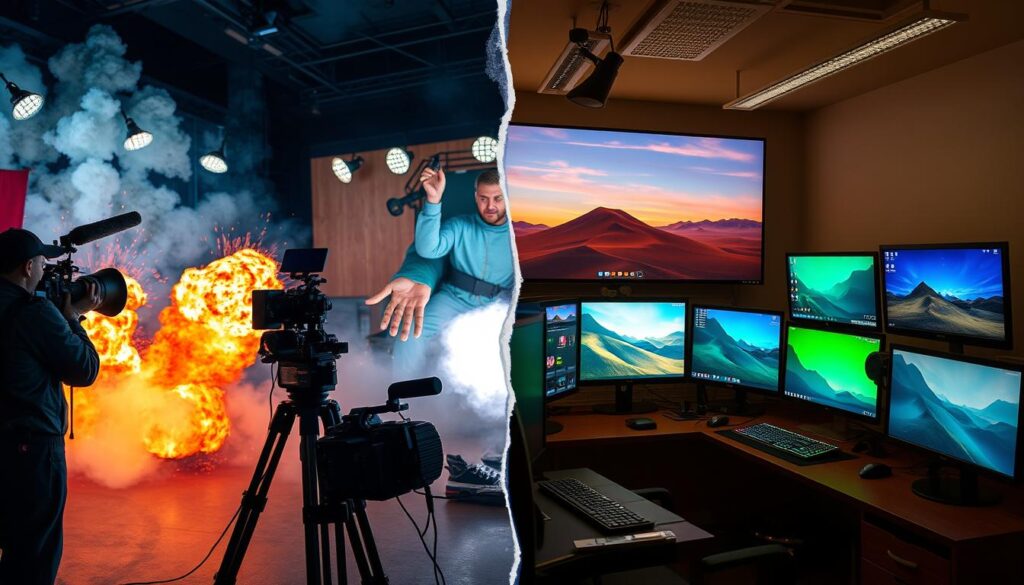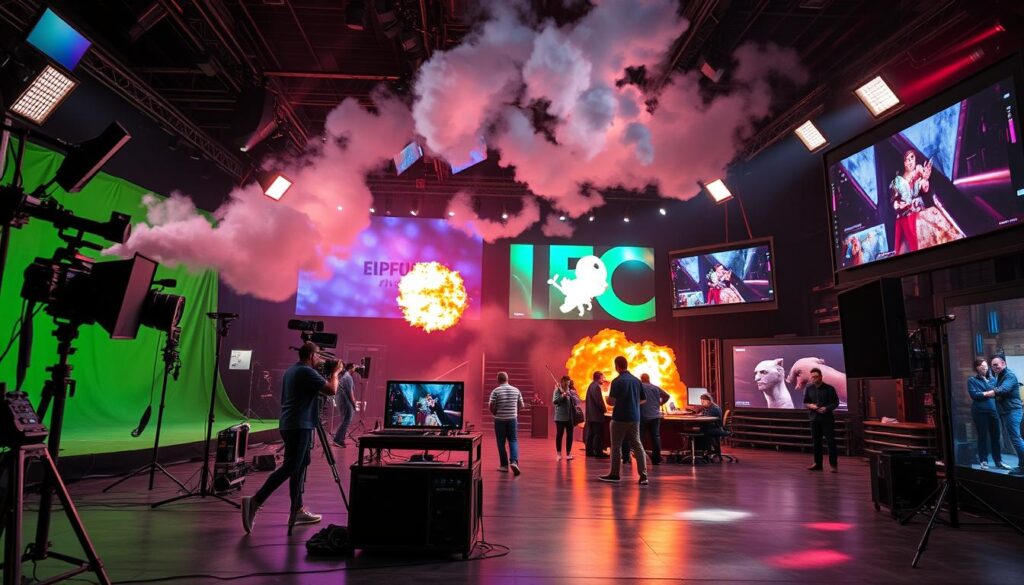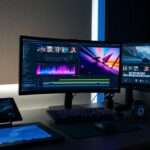The world of visual effects (VFX) is nothing short of enchanting, seamlessly merging art and technology in both film and television. As a powerful tool in modern storytelling, visual effects breathe life into narratives, allowing creators to push the boundaries of their imagination. From fantastical landscapes to jaw-dropping action sequences, the magic of visual storytelling lies in the ability of VFX to captivate audiences and enhance the viewer experience.
In this article, we will delve into various aspects of visual effects, examining how they not only enrich cinematic narratives but also influence the way we engage with stories across a multitude of genres.
Key Takeaways
- Visual effects play a crucial role in enhancing storytelling in film and television.
- They enable filmmakers to create scenes that extend beyond practical limitations.
- The integration of VFX captivates audiences and elevates viewer engagement.
- VFX technology continuously evolves, reshaping how stories are told.
- The art of VFX involves a blend of creativity and technical expertise.
The Role of Visual Effects in Modern Storytelling
Visual effects play a pivotal role in shaping modern storytelling across various media. Through the integration of advanced technology, filmmakers enhance the emotional depth of their narratives, creating visually stunning landscapes that transport audiences into new worlds. This transformation of story presentation allows for innovative narrative techniques that captivate viewers.
Notable examples can be found in acclaimed films such as Avatar, which utilizes groundbreaking visual effects to craft an immersive experience, redefining the boundaries of storytelling. Similarly, the series Game of Thrones showcased the power of VFX in bringing mythical creatures and epic battles to life, leaving a lasting impact on its audience.
In current media landscapes, the necessity of visual effects has become clear, as they foster engagement and maintain viewer interest. By combining emotion with spectacle, visual effects not only enhance the narrative but also redefine how stories are told today. The artistry behind VFX contributes significantly to the overall impact of modern storytelling.
What Are Visual Effects?
Visual effects play a crucial role in modern filmmaking, allowing creators to craft stunning imagery that captures audience imagination. The visual effects definition encompasses digital alterations and creations that enhance storytelling, offering an overview of visual effects that showcases their significance in both films and television. As technology advances, the use of VFX expands, pushing creative boundaries while ensuring authenticity.
Definition and Overview
At its core, visual effects refer to the process of manipulating or generating images by computer software, resulting in a seamless integration of live-action footage and enhanced visuals. This overview of visual effects highlights their essential use in making impossible scenes believable, whether through fantastical environments or realistic character animations. By combining artistry and technology, VFX artists elevate narratives and engage audiences more profoundly.
Types of Visual Effects
Numerous types of visual effects adapt to various storytelling needs. Two prominent categories include:
- CGI (Computer-Generated Imagery): This type creates visuals through computer graphics, allowing for intricate designs and animations that convey complex ideas.
- Practical effects: These are achieved physically on set using models, pyrotechnics, and animatronics instead of digital manipulation, providing a tangible realism to scenes.
Both areas of visual effects serve to enhance the overall production quality. Understanding the distinctions among the types of visual effects adds depth to the appreciation of modern cinematography.
| Type of Visual Effect | Description | Example |
|---|---|---|
| CGI | Imagery created using computer graphics. | Animated characters in films like “Avatar.” |
| Practical Effects | Physical effects created on set. | Explosions using pyrotechnics in “Mad Max: Fury Road.” |
| Compositing | Combining visual elements from different sources into a single image. | Layering background images with live action in “Jurassic Park.” |
| Motion Graphics | Animated graphic design that communicates information. | Title sequences in “Game of Thrones.” |
The Evolution of VFX in Film and TV
The journey of visual effects in film and television showcases remarkable advancements from rudimentary techniques to cutting-edge technology. Understanding the evolution of visual effects reveals the creativity and dedication of filmmakers over the decades. From the earliest methods utilized in classic cinema to the sophisticated CGI dominating modern productions, each era has contributed significantly to the art of storytelling.
Early Techniques to Modern Advances
Historical VFX techniques laid the groundwork for contemporary practices in the film industry. Early films relied heavily on practical effects such as:
- Rear projection
- Miniatures and models
- Glass matte paintings
- Stop-motion animation
These foundational methods enabled filmmakers to create stunning visuals despite technical limitations. The introduction of groundbreaking films like “Star Wars” in the late 1970s marked a pivotal moment, showcasing the potential of advanced visual effects. This film combined practical effects with innovative techniques, revolutionizing the industry.
As technology advanced, the evolution of visual effects saw the emergence of computer-generated imagery (CGI). This transition allowed for unparalleled creativity, changing how stories were visualized on screen. CGI provided filmmakers the flexibility to create expansive worlds and lifelike characters, enhancing viewer engagement and immersion.
The continuous evolution of visual effects not only transformed filmmaking but also set new benchmarks for other forms of media. The blend of historical VFX techniques with contemporary innovations highlights the importance of adapting and embracing new technologies in storytelling. This journey reflects the dynamic nature of visual effects and the endless possibilities for future advancements in the industry.
CGI: A Game Changer for Filmmaking
Computer-generated imagery (CGI) has fundamentally altered the landscape of visual effects in film, marking a significant turning point in the filmmaking revolution. This technology allows filmmakers to create stunning, immersive worlds and characters that transcend the limitations of traditional filming techniques.
Understanding CGI in Visual Effects
CGI serves as a powerful tool in visual storytelling, enabling artists and filmmakers to construct extraordinary scenes that can captivate audiences. Through advanced algorithms and rendering techniques, CGI integrates seamlessly with live-action footage, enhancing the overall narrative and aesthetic appeal of influential CGI films.
Notable CGI Breakthroughs in Cinema
Several landmark films illustrate notable CGI breakthroughs that have redefined expectations in cinema. For instance, “Jurassic Park” brought dinosaurs to life in a way that seemed astonishingly real, paving the way for future projects. Similarly, “The Lord of the Rings” showcased the ability to create entire fantastical worlds, pushing the boundaries of what was possible with computer-generated imagery. These pioneering efforts have not only captivated audiences but have also set new benchmarks for realism in digital effects.
Exploring Motion Graphics
Motion graphics play a transformative role in the realms of film and television creatives. These dynamic visuals not only enhance storytelling but also capture audience attention in unique ways. Frequently utilized in opening credits, promotional materials, and as integral narrative devices, motion graphics significantly shape viewer perception and engagement.
Importance in Film & TV Creatives
For filmmakers and television creatives, motion graphics serve as essential tools for visual communication. They bring static concepts to life, enriching the narrative experience. By combining animated elements with text, filmmakers can convey complex ideas succinctly. Notable films and series expertly leverage motion graphics to establish tone and mood while guiding emotions throughout the viewing experience.
Applications Beyond Traditional Filmmaking
Beyond traditional applications in film and television, motion graphics extend their influence into various industries. Advertising often employs these techniques to create compelling visual campaigns, engaging consumers effectively. Additionally, video games utilize motion graphics to enhance gameplay, adding layers of visual storytelling. Corporate presentations also benefit from motion graphics applications, transforming mundane data into visually appealing formats that retain audience interest.
3D Animation: Bringing Characters to Life
3D animation plays a crucial role in modern filmmaking and television by effectively bringing characters to life. This technology allows artists to create immersive worlds and lifelike representations through advanced character design techniques. As a result, viewers are drawn deeper into narratives, experiencing stories in a more engaging way.
The evolution of animation software has made it easier for creators to develop complex characters with unique personalities. Rigging, modeling, and texturing have streamlined the character design process, producing results that leave a lasting impact. Animated films like Toy Story and series such as Avatar: The Last Airbender exemplify the captivating use of 3D animation in visual storytelling. These productions showcase the seamless integration of dynamic movements and emotions in characters, allowing audiences to form connections.
Advanced techniques in 3D animation enhance the storytelling experience. By leveraging motion capture data, animators can translate human movements onto animated characters, resulting in a more authentic and relatable portrayal. This innovation illustrates how character design principles focus not only on aesthetics but also on the essence of storytelling.
| Feature | Traditional Animation | 3D Animation |
|---|---|---|
| Character Movement | Frame-by-frame drawing | Digital rigging and motion capture |
| Visual Detail | 2D dimensions | Rich textures and depth |
| Production Time | Longer due to individual frames | Streamlined with software tools |
| Flexibility | Limited adjustments | Easy modification of models and environments |
In summary, 3D animation significantly enhances character design and visual storytelling, transforming how stories are told on screen. This technology continues to push the boundaries of creativity, ensuring audiences remain captivated by each production.
Compositing: The Art of Combining Elements
Compositing serves as a critical component in visual effects, a technique focused on merging different visual elements into a cohesive whole. This process enhances storytelling by enabling filmmakers to blend CGI with live-action footage seamlessly. The practice leverages various visual effects techniques that allow for the creation of stunning visuals that captivate audiences.
At its core, compositing involves layering images, graphics, and effects to craft specific scenes. Common software used in this field includes Adobe After Effects, Nuke, and Blackmagic Fusion. These tools enable artists to manipulate elements meticulously, ensuring that various components harmonize well with one another.
The technical principles behind compositing require strong attention to detail. Artists must take into account factors such as lighting, shadows, and color grading to achieve realism. Achieving a believable result necessitates a thorough understanding of how these factors influence the way we perceive images.
- Green screen keying: Isolating subjects from their backgrounds.
- Rotoscoping: Tracing over live-action footage to create animated sequences.
- Digital matte painting: Crafting photorealistic environments.
The art of combining visuals not only requires technical expertise but also creativity and vision. A successful composite can elevate a film or television production, making complex scenes appear effortless and believable.
| Technique | Description | Common Applications |
|---|---|---|
| Green Screen Keying | Creating an alpha channel to extract subjects from backgrounds. | News broadcasts, action films, commercials. |
| Rotoscoping | Manually tracing over footage for animation or effects. | Animated features, visual storytelling. |
| Digital Matte Painting | Creating detailed backgrounds using digital tools. | Fantasy films, epic landscapes. |
Rendering: The Technical Backbone of Visual Effects
The rendering process is pivotal within the realm of visual effects, transforming intricate 3D models and scenes into breathtaking images. This complex system serves as the technical backbone, ensuring that every detail is captured and presented in high quality. As filmmakers push the boundaries of what is visually achievable, understanding the rendering process becomes essential for achieving stunning results.
The Rendering Process Explained
At its core, the rendering process involves several key steps that translate digital information into the final visual output. This journey starts with scene preparation, where assets are organized, textures are applied, and lighting conditions are set. Once the scene is ready, the rendering tools take over to process each pixel, creating depth, reflections, and shadows that enrich the image. This intricate interplay results in a final visual that beautifully tells the story intended by the creators.
Tools Used in Rendering
The choice of rendering tools plays a critical role in the efficiency and quality of the process. Popular visual effects software such as Arnold, V-Ray, and RenderMan are used across the industry for their unique capabilities and features. These tools differ not only in the rendering speed but also in the level of realism they can achieve. Understanding these nuances helps filmmakers and artists choose the right tools for their specific projects, ultimately enhancing the visual impact of their work.
VFX Software: Tools of the Trade
In the realm of visual effects, a variety of VFX software plays a crucial role in bringing cinematic visions to life. Each package offers unique features tailored to specific aspects of visual effects production, catering to artists and studios alike. Below are some of the most popular software options for visual effects.
Popular VFX Software Options
| Software | Key Features | Best For |
|---|---|---|
| Adobe After Effects | Compositing, motion graphics, animation tools | 2D animations and visual effects integration |
| Blender | 3D modeling, rendering, and simulation | Both beginners and advanced users |
| Maya | 3D animation, character rigging, dynamics | Professional character and environment creation |
| Nuke | Node-based compositing, 3D capabilities | High-end film production and broadcast |
| Cinema 4D | 3D graphics and motion graphics | Dynamic and intuitive motion graphics creation |

Visual Effects Artists: The Creative Minds Behind the Magic
Visual effects artists play a pivotal role in transforming a film’s vision into reality. Their creative process combines artistry and technical skill, enabling them to create stunning visual narratives. Each artist brings unique inspirations, often drawing from a diverse range of sources, including fine art, photography, and even nature. This variety enriches the visual language of film and television.
Their work begins with concept development, where ideas are nurtured through sketches and prototypes. Collaboration is vital, as visual effects artists work alongside directors, cinematographers, and other creatives to ensure that the imagery aligns with the overall vision for the project. This collaborative spirit facilitates a dynamic exchange of ideas, techniques, and feedback throughout the production.
The technical aspects of their craft cannot be overlooked. Mastery of sophisticated software tools is essential for visual effects artists, allowing them to manipulate digital assets that breathe life into characters and environments. The balance between creativity and technical prowess is what enables these artists to captivate audiences with their work.
Ultimately, the journey of a visual effects artist involves much more than technical skill. It requires an ongoing commitment to innovation and a deep understanding of storytelling through visuals. This combination of talent and technique generates the magical experiences that audiences have come to love in modern cinema.
Post-Production: The Final Touches in Film & TV
Post-production serves as a vital stage in the filmmaking process, acting as the final opportunity for filmmakers to polish their narrative. During this phase, visual effects integration takes center stage, as it’s essential for unifying various elements like sound, editing, and visuals into a cohesive product. Each detail must work in harmony to evoke the intended emotion and storytelling impact.
Effective post-production involves multiple stages, including editing, color correction, and sound design, culminating in the seamless integration of visual effects. This intricate process enhances the story and bridges any gaps between reality and imagination, allowing audiences to fully immerse themselves in the film or television experience.
| Element | Description |
|---|---|
| Editing | Cutting and assembling footage for a coherent narrative. |
| Visual Effects Integration | Incorporating CGI and other effects to enhance storytelling. |
| Color Correction | Adjusting colors to create mood and consistency. |
| Sound Design | Creating audio elements that complement the visuals. |
| Final Mixing | Balancing sound elements for an optimal auditory experience. |
The impactful outcomes of post-production truly underscore its importance. A well-executed post-production phase ensures that all elements work together, forging a powerful connection with the audience throughout the viewing experience.
Special Effects vs. Visual Effects: Understanding the Difference
The terms special effects and visual effects often generate confusion among audiences and even within the film industry. Both play crucial roles in storytelling, yet they differ significantly in their execution and purpose.
Special effects refer to practical effects created during filming. These include physical stunts, pyrotechnics, animatronics, and makeup, providing authentic elements that contribute to the film’s realism. This hands-on approach often requires skilled artists and technicians on set. In contrast, visual effects encompass post-production techniques primarily executed through digital means. Using computer-generated imagery (CGI), artists can create stunning environments, fantastical creatures, and enhance live-action footage.

Understanding the visual effects difference helps illuminate how directors and producers blend these two techniques to engage viewers. While working on a film, filmmakers might use special effects to achieve immediate and visceral reactions, while visual effects build upon those foundations, adding layers of depth through digital enhancements.
| Aspect | Special Effects | Visual Effects |
|---|---|---|
| Definition | Practical effects created on set | Digital manipulation and enhancements |
| Execution | In-camera during filming | Post-production editing |
| Examples | Explosions, animatronics, makeup | CGI environments, digital compositing |
| Realism | Provides a tangible experience | Enhances and enriches the visual narrative |
Both special effects and visual effects contribute to the magic of cinema, making it essential to appreciate their unique roles in creating captivating stories.
Conclusion
In summary, visual effects in film and TV play a crucial role in shaping modern storytelling. These techniques, from CGI to motion graphics, are not just enhancements but essential tools that expand the creative possibilities available to filmmakers. The article has explored how VFX allows for the magical integration of art and technology, creating immersive experiences that captivate audiences worldwide.
The evolution of visual effects has transformed from simple techniques to advanced digital artistry, illustrating the growing importance of VFX in the industry. As we reflect on our conclusion on VFX, it’s clear that these innovations have not only redefined storytelling but have also provided new avenues for artistic expression. The future of filmmaking undoubtedly lies in the continued advancement of visual effects.
Ultimately, the integration of visual effects in film and TV ensures that audiences are continuously engaged with increasingly complex narratives and stunning visuals, fostering a richer, more dynamic cinematic landscape. VFX has become synonymous with creativity, pushing the boundaries of what can be achieved on screen.


